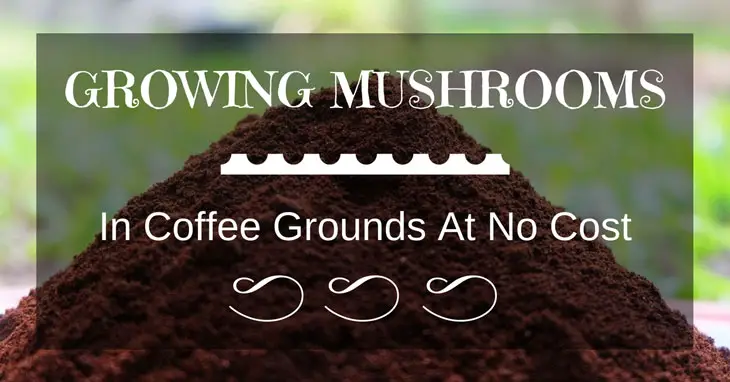Growing Mushrooms in Coffee Grounds at No Cost
Oyster and Shiitake and other types of mushrooms are gaining in popularity as a gourmet food item. Because of the booming demand for mushrooms, there is a good opportunity to cash in on these fungi. And you don’t need acres of land to grow them. Growing mushrooms in coffee grounds are possible, and it will not cost you anything.
Mushrooms grow rapidly in cool, dark, and humid environments. They produce spores which are used to make spawns on carbon-rich materials. They include straw, sawdust, straw, manure or decaying log. Mushrooms grow best in carbon-rich medium.
We can’t grow mushrooms in ordinary garden soil. However, growing mushrooms in coffee grounds are possible. And why not? Used coffee grounds are organic materials that are cohesive, sterilized and rich in carbon. In fact, coffee grounds are composed of a 20:1 carbon-to-nitrogen ratio. These characteristics make growing mushrooms in coffee grounds possible.
More...
5 Easy Steps in Growing Mushrooms in Coffee Grounds
1. Gather the materials
Growing mushrooms in coffee grounds are inexpensive. In many cases, you can do it for free. You just need to be resourceful in finding the materials. Most of these materials may already be available in your home. Some of them you can get for free. Growing mushrooms in coffee grounds will require the following:
- Bucket or container (Most growers use a 5-gallon plastic pail.)
- Lots of ground coffee (You can obtain sterilized coffee ground from coffee shops in your area. Your container should be half full.)
- Mushroom spawn
- Spray bottle
- Plastic wrap
Note: If you think it will take a while before you can collect all the needed coffee grounds, store what you have already collected in the freezer. Mushrooms need to grow in a sterilized media so that they won’t compete with other fungi. Keeping them in the freezer will prevent mold and other fungi from growing in the coffee grounds.
When you are ready to use, you can take the coffee ground out of the freezer for at least 24 hours before using them.
2. Prepare the planting materials
Drill several holes around the edge of the bucket. The holes should be just over the surface line of the coffee grounds. During the waiting period, you’ll cover the bucket with a plastic wrap. Without these holes, the carbon dioxide will build up inside. This can hinder the growth of the mushrooms.
The next thing to do is to fill your bucket half-full with coffee grounds. Make sure they will not cover the holes. If the coffee grounds are dry, moisten them a little, but do not saturate. You can use the spray bottle for this purpose.
3. Plant the spawns
Shiitake and Oyster Mushroom spores normally cost around $1 per gram. Some variety may be more expensive. But you can get them for free. Mushrooms spores are easy to collect. Just follow this short video on how to do it
From spores, here is a video on how to make your spawn
When the spawn is ready, break up the mixture and mix them directly on the coffee ground’s top surface. After mixing, gently press the grounds using your hands.
4. Waiting time
After mixing the spawn with the coffee grounds, it’s time to cover the bucket with the plastic wrap. Before putting it away, make sure to poke some tiny holes in the wrap for air. This is necessary to keep the mushrooms moist.
Keep the bucket in a warm and dark corner. Leave it and watch as the mushrooms grow. In the next two to three weeks, you will see the spawn growing white fibers all over the surface. The white fibers are called mycelium. They will spread the coffee grounds mixture and break it down for food.
An important point to remember: Check the surface area for any spots of green. These are competitor mold which can hinder the growth of the mushrooms. It is easy to get rid of mold by putting a pinch of salt where it is present. If you see an entirely green bag, you may have to start all over again.
5. Proper care
After three weeks, you may now transfer the bucket to a place with dim light and fresh air. Before you transfer the bucket to a new location, remove the plastic wrap. During this time, be sure to keep the coffee grounds surface moist by spraying water twice a day. Mushrooms grow best in a moist and humid place. Mushrooms prefer an environment with a cool temperature of around 70°F. (http://homeguides.sfgate.com/environment-mushroom-growth-28551.html)
In a matter of days, tiny mushrooms will start to emerge and burst out of the hole. They will double in size in one day until they are fully ripe. This is when the edges of the caps start to turn upwards.
After you harvested the mushrooms, you can reseal it with the plastic wrap and wait for the next flush. They normally appear in about a week.
Interesting Facts You Might Want to Know
Most popular variety to grow. The two most popular mushrooms that you can grow on coffee grounds are shiitake mushrooms and oyster mushrooms. They are easiest to grow for beginners. Plus, these two mushrooms are known for their health benefits:
- Shiitake mushrooms – These mushrooms contain chemical compounds that protect the DNA from damage. For instance, it contains a compound called “lentinan.” This compound heals damage in the chromosomes caused by anticancer treatments. Moreover, it has “eritadenine” which helps in the reduction of cholesterol level. This substance also supports cardiovascular health. Moreover, shiitake mushrooms also help in weight-loss and digestion. It is also great for reducing food allergies. (https://draxe.com/shiitake-mushrooms/ )

- Oyster Mushrooms – Oyster mushrooms have a long history of use as a culinary and medicinal ingredient. It contains a significant amount of ergothioneine. This is an antioxidant that protects the cells in our body. Moreover, it is rich in antibacterial properties. This is according to a study published in the "Journal of Agricultural and Food Chemistry." In the said study, they found out that oyster mushrooms contain benzaldehyde which helps in reducing the bacteria levels. (http://www.livestrong.com/article/348755-oyster-mushroom-health-benefits/)

Oyster Mushroom
Hygiene is important. For mushrooms to grow, it is important to reduce the number of bacteria, fungi and other competitive organisms. That is why pasteurized coffee grounds are great for growing mushrooms.
Mold, your greatest enemy. The mold may also thrive in the same environment that mushrooms grow. When you notice signs of mold, reduce the amount of water you spray. You may also have to move your bucket to a cooler location.
Coffee grounds don’t go bad. This means that after harvesting, you can keep the coffee grounds in a sealed container for next use. The mycelium will not bloom until you start watering it. You may also use it as spawn for another batch.
Growing mushrooms in coffee grounds have a positive environmental impact. Growing mushrooms in coffee grounds are exciting and fulfilling. Exciting because you get to harvest expensive mushrooms for free. It is fulfilling because this method has the following environmental impact:
- Reduction of greenhouse emissions - Mushrooms break down the coffee grounds for food. This, in turn, reduces the potential greenhouse gas emissions as unused coffee grounds biodegrade on their own. Mushrooms are great nature recyclers.
- Upcycled byproducts - Once used, coffee grounds make a great soil enhancer. You can mix them with ordinary garden soil to grow plants.
Conclution
You can cultivate mushrooms in your own home using coffee grounds at no cost. You just need to gather the materials and follow the correct procedure we listed above. Growing mushrooms in coffee grounds can be tricky, but it’s quite easy once you get used to it.
Did you find this article helpful? Please share with us your thoughts through the Comment section. You may also like to share this article with your friends.

